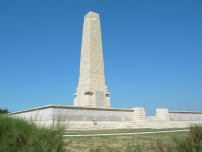| First Name: | Alexander | Last Name: | ANDERSON | |
|---|---|---|---|---|
| Date of Death: | 25/04/1915 | Lived/Born In: | Euston | |
| Rank: | Private | Unit: | Royal Fusiliers2 | |
| Memorial Site: | Helles Memorial, Gallipoli | |||
Current Information:Born-St Pancras
On 25 April, 1915, British, Australian and New Zealand forces landed on the Gallipoli peninsula. The plan was that these forces would soon defeat a demoralised Turkish army, knock Turkey out of the war, open up the Mediterranean to the Russian navy and threaten Austro-Hungary from the south.None of these things were achieved despite nine months of hard fighting in terrible conditions. It was a heroic failure. The 29th Division and the Royal Naval Division landed at five separate beaches around Cape Helles. Some were not defended, others were fiercely contested. Some ground was gained but within days the familiar pattern of trench warfare had set in. A similar pattern emerged further north where the ANZACS landed. The Turkish soldiers were much tougher fighters than had been given credit for and they were of course fighting an invasion of their homeland. The terrain, a series of steep rocky ridges and deep gullies made the fighting much more difficult and during the hot summer of 1915, the flies arrived in biblical proportions. Another seven British divisions were sent to Gallipoli during the summer but little or no progress was made. In the end, a new Commander was appointed and plans to evacuate the entire force were drawn up. By January 1916, all British, Australian and New Zealand forces had left Gallipoli, leaving only behind the dead, over 56,000 of them. On 25th April, 1915, the 2nd Royal Fusiliers battalion of 86 Brigade, 29th Division, landed at “X” Beach on Cape Helles. “X” Beach was a small natural amphitheatre with a narrow floor of sand some 200 yards long on the north-west face of the peninsula from which cliffs rose steeply for one hundred feet with no natural way up. Pinnaces towed the boats in to within one hundred yards of the shore line from where the men of “X” & “W” Companies stumbled ashore and scrambled up the cliff with hardly any casualties. Fire from HMS Implacable kept Turkish heads down and made this possible but that was the limit of this naval assistance. At this stage the troops ran into heavy converging fire but pressed on and seized a Turkish trench. “Y” and “Z” Companies then disembarked and moved to the right to make contact with the 1st Lancashire Fusiliers at “W” Beach and took Tekke Hill (Hill 140) in the process. Moving further on 2nd Royal Fusiliers met considerable opposition on other side of the hill so they dug in. Here they fought off a number of Turkish counter attacks. On the following day, 26th April, there were two strong Turkish attacks on the rough trenches held by 2nd Royal Fusiliers, both of which were repelled, but not without cost. Things quietened down over the next two days and new trenches were carved out of the rocky terrain. Among the many casualties suffered by the battalion during these early days of the landing was Alexander Anderson who was killed on 25th April. |
||||
| « Back to Search Results | ||||
| If you think any of the information shown here is incorrect, Click Here to submit your amends and comments | ||||




